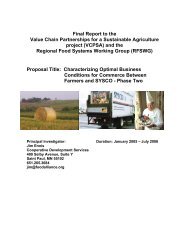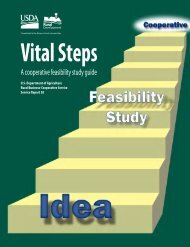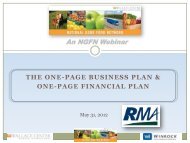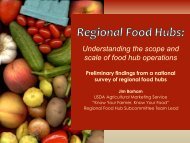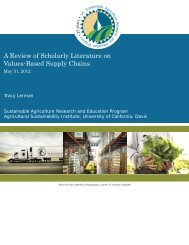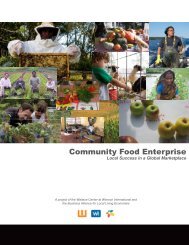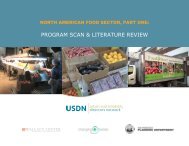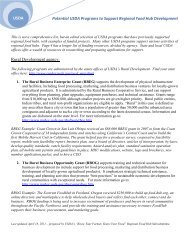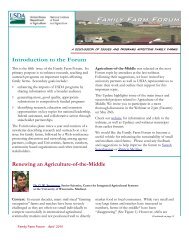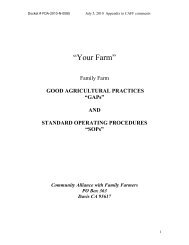The Common Market Feasibility Study - Agricultural Marketing Service
The Common Market Feasibility Study - Agricultural Marketing Service
The Common Market Feasibility Study - Agricultural Marketing Service
You also want an ePaper? Increase the reach of your titles
YUMPU automatically turns print PDFs into web optimized ePapers that Google loves.
THE COMMON MARKET FEASIBILTY STUDYExecutive Summary13• Products produced on the farm, wholesale market readiness, potential or interest in producingnew or different products• Current sales and marketing practices and experience and/or barriers to participating in thewholesale trade• Interest in working with a business like the <strong>Common</strong> <strong>Market</strong> model<strong>The</strong> panel participants, along with the analysis of Pennsylvania (PA) state and United States Departmentof Agriculture (USDA) statistical data, indicate that enough products are produced in close proximity toPhiladelphia to support a distribution business proposed by the <strong>Common</strong> <strong>Market</strong> (in terms of productmix and volume). <strong>The</strong> panel respondents operate financially successful farms and have found ways tomarket that sustain them economically. Many of the farmers interviewed have focused theiroperations on direct-retail and direct-wholesale sales. Nevertheless, respondents indicated an interestin working with a business like the <strong>Common</strong> <strong>Market</strong>. <strong>Common</strong> <strong>Market</strong> managers will need to focussignificant efforts on developing a reliable network of farms to meet the wholesale demand of theirtarget markets. More "wholesale ready" farms need to be identified while other farms need to bothexpand existing operations to diversify their sales into wholesale markets facilitated by the proposedbusiness. Key elements for farmer participation include the organizational, operational and capitalissues identified below.Organizationally, there is a clear desire on the part of producers to work with a wholesaler ordistributor that will provide better access to local markets and treat them in more respectful, nonexploitativemanner. <strong>The</strong>refore, the <strong>Common</strong> <strong>Market</strong>’s value proposition for prospective suppliersshould be to provide transparency, vested interest for producers, transportation services, professionalsales representation, secure financial backing to ensure timely payment, and quick and fair disputeresolution.Operationally, the <strong>Common</strong> <strong>Market</strong> will require a facility to receive, store, prepare, assemble andship products; trucks to deliver (and possibly pickup from farms) products; and a staff for logistics (for alltrucking and internal handling), sales and management. Sales will require adequate staffing to maintainregular, consistent, informed contact with the customer base while prospecting for new customers.Capacity to produce certain value-added product would increase farmer interest. Specifically this wouldinclude a USDA butchering facility with storage and freezing equipment and freezer storage for bothmeats and fresh produce items for out-of-season sales.Capital will be an important component to the success of the <strong>Common</strong> <strong>Market</strong>. Appropriatecapitalization of facilities will be necessary to provide the necessary services to interest farmers andproducts for customers. In addition, farmers participating in the producer panels indicated a strongdesire for fast pay. <strong>The</strong>refore, the <strong>Common</strong> <strong>Market</strong> will require adequate access to cash to cover thespread between fast payment terms and its receivables.



